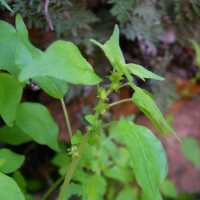Herbs , annual or perennial, sparsely to densely pubescent with hooked and straight, nonstinging hairs on all parts of plant, stinging hairs absent. Stems often branched from base, erect, ascending, or decumbent. Leaves alternate; stipules absent. Leaf blades deltate, orbiculate to narrowly elliptic, or lanceolate, margins entire; cystoliths rounded. Inflorescences axillary. Flowers bisexual, staminate, or pistillate, proximal flowers usually bisexual and staminate, distal flowers pistillate; involucral bracts linear to lanceolate, without hooked hairs; tepals 4, distinct, ascending, lacking hooked hairs; stamens 4; style persistent or not; stigma tufted, deciduous. Achenes stipitate, ovoid, acute or mucronate (style base sometimes persisting as apical or subapical mucro), loosely enclosed by tepals. x =7, 8, 10, 13.
Mature achenes are necessary for certain determination.
Parietaria nummularifolia (Schwartz) Weddell was collected once in 1992 in Palm Beach County, Florida, in mesic woods bordering a creek (R.P. Wunderlin, pers. comm.). This species is occasionally cultivated, and the Florida collection probably represents an escape.
PLANT: Erect, ascending, or decumbent, polygamous, sparsely to densely hairy, annual or perennial herbs, often branched from the base.
LEAVES: alternate, estipulate, the blades triangular, circular to narrowly elliptic, or lanceolate, entire, one or both surfaces with punctiform cystoliths that appear as minute pustules.
INFLORESCENCE: of few flowered axillary cymes, the lowermost flowers usually perfect, those above pistillate.
FLOWERS: subtended by 1 3 linear to lanceolate bracts; tepals 4; stamens 4; ovary short stipitate on a ciliate, disklike receptacle.
FRUITS: shining, hard and bony, ovoid, stipitate achenes, enclosed by the perianth; stipe ring like or very short cylindrical and flanged, the style base persisting as an apical [ours] or subapical mucro or deciduous.
NOTES: 20 30 spp. primarily in temperate and subtropical regions. (Latin: based on paries = wall).
REFERENCES: Boufford, David E. 1992. Urticaceae. Ariz.-Nev. Acad. Sci. 26(1)2.
Monoecious or polygamous; staminate fls with deeply 4- parted cal and 4 stamens; cal of the pistillate fls tubular at base, 4-lobed; ovary compressed, ovoid; stigma subsessile; fr an achene, loosely enclosed by the accrescent cal; herbs with alternate, entire, exstipulate lvs and short, axillary clusters of few fls subtended and exceeded by green bracts. 30, widespread.
Gleason, Henry A. & Cronquist, Arthur J. 1991. Manual of vascular plants of northeastern United States and adjacent Canada. lxxv + 910 pp.
©The New York Botanical Garden. All rights reserved. Used by permission.






